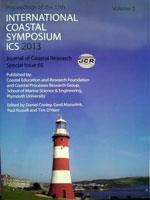Leite, N.R., Magalhães, A., Palma, M.B., Flores Montes, M., Pereira, L.C.C. and Costa, R.M. da, 2013. Diel variation in the zooplankton of a highly dynamic Amazonian estuary. In: Conley, D.C., Masselink, G., Russell, P.E. and O'Hare, T.J. (eds.), Proceedings 12th International Coastal Symposium (Plymouth, England), Journal of Coastal Research, Special Issue No. 65, pp. 1146–1151, ISSN 0749-0208.-->
The short-term dynamics (circadian and tidal cycles) of the zooplankton community were investigated in the Taperaçu estuary in northern Brazil. The plankton samples were collected in April (rainy season) at a fixed station, located in the middle sector of this estuary, through horizontal tows (plankton net with 200 μm mesh), every 3 hours over a 24-hour period, during the spring tide. Altogether, 51 zooplankton taxa were identified, of which the copepods Paracalanus quasimodo (34.6 to 13,852.8 ind.m−3; mean: 2,320.8±3,842.2 ind.m−3), Labidocera fluviatilis (2.0 to 3,209.2 ind.m−3; mean: 484.5±804.4 ind.m−3), Pseudodiaptomus marshi (9.7 to 1,599.6 ind.m−3; mean: 453.9±580.5 ind.m−3), and Acartia tonsa (27.6 to 3,953.6 ind.m−3; mean: 694.4±1,269.4 ind.m−3) were the dominant species. While no significant short-term variation was observed in hydrological or biological parameters, fluctuations related to tidal height were recorded in abiotic parameters and the density of the principal zooplankton taxa. The temporal variation in copepod populations tended to reflect that of total zooplankton abundance. Mean zooplankton density varied from 509.1 ind.m−3 (ebb tide, at 16:30 h) to 25,514.3 ind.m−3 (flood tide, at 10:30 h), with an overall mean of 5,872.1±8,286.4 ind.m−3. Oscillations in the density of P. quasimodo, L. fluviatilis, and P. marshi were influenced by the morphological and morphodynamic characteristics of the Taperaçu estuary, associated with the recruitment of individuals from the adjacent Caeté estuary, which constitutes an important factor determining the structure of the zooplankton community recorded in the present study.





